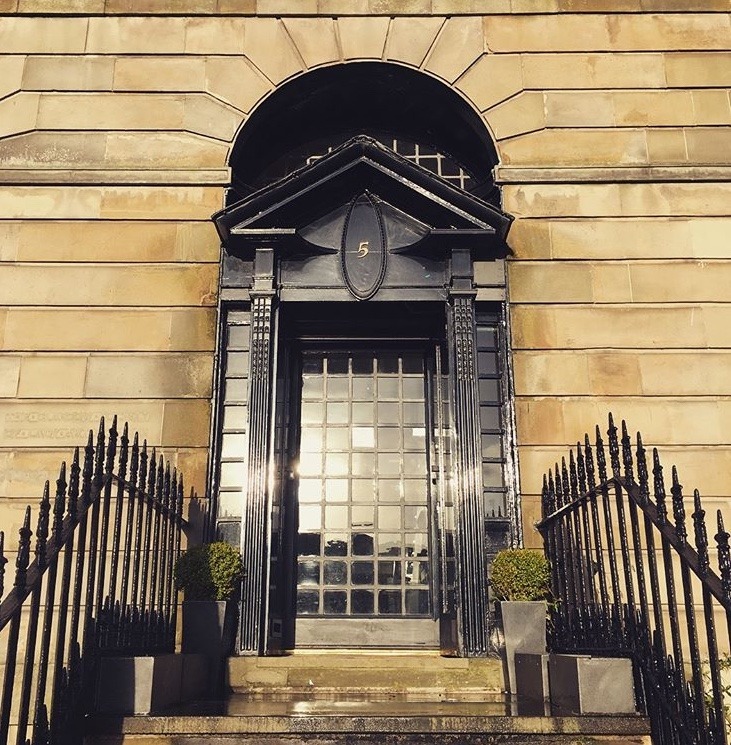By Dr. Karen Mailley-Watt
‘There is no assumption that feminism looks the same in each place or time.’
– Lucy Delap, Feminisms: A Global History.
A RADICAL HISTORY
5 Blythswood Square – a blonde sandstone townhouse – now home to office workers, computers and time-consuming board meetings, contains within its walls a radical history not many Glaswegians, never mind many Scots, acknowledge. Nestled amongst other picturesque buildings, 5 Blythswood Square, just a stone’s throw away from The Glasgow School of Art (GSA), proudly stands out from the rest with its custom-commissioned doorway designed by the renowned architect and designer Charles Rennie Mackintosh (1868-1928). His fame reaches around the world.However, the women who commissioned the unique entrance to the townhouse in 1908 are not as celebrated, nor fully acknowledged in Glasgow’s history. But they should be. Throughout the club’s history it boasted a multitude of pioneering women including the teacher and artist Ann Macbeth (1875-1948), the architects Edith M.B Hughes (1888-1971) and Margaret Brodie (1907-1997), and the campaigner, rebel-rouser and Suffragette Janie Allan (1868-1968).
THE GLASGOW SOCIETY OF LADY ARTISTS (GSLA)
The GSLA was established in 1882 by a group of GSA students in an attempt to combat the everyday sexism and misogynistic barriers which actively prevented them from progressing and flourishing in Scotland’s art world. With the Glasgow Art Club and The Royal Glasgow Institute of the Fine Arts not accepting women until the 1980s, the early members of GSLA made it their mission to create a club which would help to promote the work of female artists and designers, to provide exhibition opportunities, and a form of sisterhood not catered for by the male-controlled art clubs in Victorian Glasgow. The formation of a women-only club was in itself an act of rebellion, more so one which physically claimed space in a city not designed, nor catering for them.
Although the club was originally designed for artists it began to cater for other women by opening up membership to ‘lay’, non-artist members in the 1890s. A lay membership allowed members access to the club house and its facilities (of which there was a fine selection) without the exhibition opportunities afforded to Artist Members. The club had two previous homes before moving permanently to 5 Blythswood Square. From the 1880s the club occupied founder member Georgina Greenlees’ (1849-1932) studio space which she shared with her father, Robert Greenlees (1820-1904), at 136 Wellington Street. He was the Headmaster of the GSA from 1863 till 1881 and is attributed by several sources as encouraging the group to form and to undertake exhibitions. Demonstrating a can-do attitude for their exhibitions, the GSLA often borrowed other rooms in the Wellington Street building from a firm of lawyers so that they had the space to exhibit all of the work they wished to show. Moving forward the club realised that this was not an adequate state of affairs. The Wellington Street space was soon deemed to be ‘too small for purposes’ and new premises were sought for the ever-growing membership. The club moved a short distance to 22 Charing Cross Mansions where they occupied three rooms which once again quickly became too small for the membership body. The expansion of membership options (Artist, Lay, Professional and Honorary) and the occupation of 5 Blythswood Square from 1893 allowed women to continue to grow a network and socialise in a female-controlled space. A safe place.
FEMINIST FORERUNNERS
These women, who established the club, were feminist forerunners who asserted their right and claim to a place in the city. The townhouse at 5 Blythswood Square had a dining room, living room, bedrooms, studio space and a custom-designed gallery (added in 1895). During the club’s history the spaces were often flexible with some being adapted to suit the evolving requirements of the membership body e.g. by the 1930s some of the studios had been changed to make way for the addition of another bedroom. The bedrooms throughout the club’s history allowed women to have a safe space to stay, unchaperoned, and without society questioning their reputations. In the 1920s and 1930s in particular the clubhouse also helped to facilitate a connection with other like-minded women’s clubs, nationally and internationally, and to allow women freedom of movement via travel and accommodation linked with GSLA.
Similar to many feminist spaces of the 1960s and 1970s, the clubhouse was a place segregated away from men and male-dominated structures. It protected, empowered and was aesthetically reflective of the community housed within. In the townhouse, GSLA members had full control over who could enter the house and when they could occupy the space. Other women’s groups in the city such as The Kelvin Ladies Club (est.1897) met in hotels or other rooms to discuss their business and did not own a private clubhouse. Men were banned from the GSLA clubhouse unless being deemed of a professional benefit to members, e.g. as visiting exhibitors, purchasing art or providing educational lectures. It was also a child-free space unless under very specific circumstances, and even then children were only allowed into the dining room. Through this active control of space, GSLA were promoting a very specific segregated space distinct from societal expectations of wifely duties and the domestic sphere of the home.
FEMINIST IDEOLOGIES
This fostering of exclusivity via membership and control of the space allowed for other pro-woman groups such as The Women’s Employment Bureau, a society established to help women gain employment, to utilise the clubhouse’s meeting room. This bubbling and cross-fertilisation of feminist ideologies allowed for many women, often pioneers in their own individual fields, to congregate at the clubhouse. Renowned suffrage campaigners associated with GSLA in the early twentieth century including Ann Macbeth, Dr Winifred Ross, Dr Katherine Chapman, Janie Allan, Eve Baker and Chris Stark. Furthermore, many other members of GSLA are recorded attending the infamous St. Andrews Bazaar in Glasgow in 1910 including Jessie M. King, Helen Paxton Brown, and De Courcy Lewthwaite Dewar as well as Chapman, Baker and Macbeth. The event aimed to raise funds for the suffrage cause via a variety of means such as stalls, auctions and entertainments. All of these women either were already GSLA members, or joined the same year as the Bazaar was held. Coincidence, or did the club support the women’s movement with its private meeting rooms, pro-woman ethos, large and engaging network and entry control to the clubhouse? A room full of radicals, or simply a comfortable meeting place for respectable ladies to take tea? I’ll let you decide.

Dr Karen Mailley-Watt is a Glaswegian historian who has a passion for rediscovering Glasgow’s radical and cultural histories in relation to the built environment. She is one half of the History Girls Frae Scotland.
Twitter: @mailley_watt
Instagram: @scottishwomenartists




